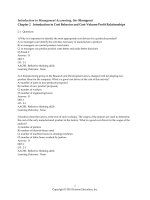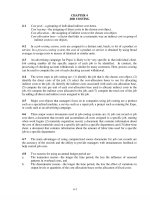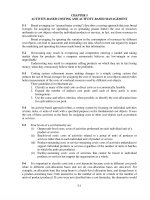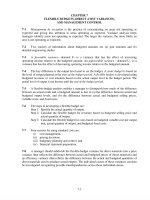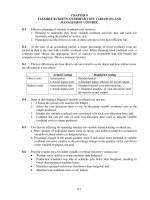Solution manual introduction to management accounting 14e by horngren ch05
Bạn đang xem bản rút gọn của tài liệu. Xem và tải ngay bản đầy đủ của tài liệu tại đây (600.21 KB, 70 trang )
To download more slides, ebook, solutions and test bank, visit
CHAPTER 5
COVERAGE OF LEARNING OBJECTIVES
LEARNING
OBJECTIVE
LO1: Discriminate
between relevant and
irrelevant information
for making decisions.
LO2: Apply the
decision process to
make business
decisions.
LO3: Construct
absorption and
contribution-margin
income statements and
identify their relevance
for decision making.
LO4: Decide to accept
or reject a special order
using the contribution
margin technique.
LO5: Explain why
pricing decisions
depend on the
characteristics of the
market.
LO6: Identify the
factors that influence
pricing decisions in
practice.
LO7: Compute a target
sales price by various
approaches, and
compare the advantages
and disadvantages of
these approaches.
LO8: Use target costing
to decide whether to
add a new product.
FUNDAMENTAL
ASSIGNMENT
MATERIAL
CRITICAL
THINKING
EXERCISES AND
EXERCISES
23,30,37,38
PROBLEMS
49,50,51,54,57
CASES, EXCEL,
COLLAB. &
INTERNET
EXERCISES
66
28,29,39
A1,B1
24,31,32,33, 34,35
48
A2,B2
36,40
55,56,62
A2,B2
25,42
58
26,41
47,52,53
A3
43,44
A4,B3
27,45,46
246
59,60,61
63,64
65
To download more slides, ebook, solutions and test bank, visit
CHAPTER 5
Relevant Information and Decision Making: Marketing Decisions
5-A1 (40-50 min.)
1.
INDEPENDENCE COMPANY
Contribution Income Statement
For the Year Ended December 31, 2006
(in thousands of dollars)
Sales
$1,800
Less variable expenses
Direct material
$400
Direct labor
330
Variable manufacturing overhead (Schedule 1) 150
Total variable manufacturing cost of
goods sold
$880
Variable selling expenses
60
Variable administrative expenses
23
Total variable expenses
963
Contribution margin
$ 837
Less fixed expenses:
Fixed manufacturing overhead (Schedule 2)
$322
Selling expenses
240
Administrative expenses
121
Total fixed expenses
683
Operating income
$ 154
247
To download more slides, ebook, solutions and test bank, visit
INDEPENDENCE COMPANY
Absorption Income Statement
For the Year Ended December 31, 2006
(in thousands of dollars)
Sales
Less manufacturing cost of goods sold:
Direct material
Direct labor
Manufacturing overhead (Schedules 1 and 2)
Total manufacturing cost of goods sold
Gross margin
Less:
Selling expenses
Administrative expenses
Operating income
$1,800
$400
330
472
1,202
$ 598
$300
144
444
$ 154
INDEPENDENCE COMPANY
Schedules of Manufacturing Overhead
For the Year Ended December 31, 2006
(in thousands of dollars)
Schedule 1: Variable Costs
Supplies
Utilities, variable portion
Indirect labor, variable portion
Schedule 2: Fixed Costs
Utilities, fixed portion
Indirect labor, fixed portion
Depreciation
Property taxes
Supervisory salaries
Total manufacturing overhead
248
$ 20
40
90
$ 12
40
200
20
50
$150
322
$472
To download more slides, ebook, solutions and test bank, visit
2. Change in revenue
Change in total contribution margin:
Contribution margin ratio in part 1
is $837 ÷ $1,800 = .465
Ratio times increase in revenue is .465 x $200,000
Operating income before change
New operating income
$200,000
$ 93,000
154,000
$247,000
This analysis is readily done by using data from the contribution
income statement. In contrast, the data in the absorption
income statement must be analyzed and split into variable and
fixed categories before the effect on operating income can be
estimated.
249
To download more slides, ebook, solutions and test bank, visit
5-A2 (25-30 min.)
1.
A contribution format, which is similar to Exhibit 5-6, clarifies
the analysis.
Units
Sales
Less variable expenses:
Manufacturing
Selling & administrative
Total variable expenses
Contribution margin
Less fixed expenses:
Manufacturing
Selling & administrative
Total fixed expenses
Operating income
Without
With
Special
Effect of
Special
Order
Special Order
Order
2,000,000
150,000
2,150,000
Total Per Unit
$10,000,000$660,000
$4.401
$10,660,000
$ 3,600,000$330,000
$ 3,930,000
800,000
37,500 .253
$ 4,400,000$367,500
$ 4,767,500
$ 5,600,000$292,500
$ 5,892,500
$ 2,900,000 0 0.00
2,000,000
00.00
$ 4,900,000
0 0.00
$ 700,000 $292,500$1.95
1 $660,000 ÷ 150,000 = $4.40
2 Regular unit cost = $3,600,000 ÷ 2,000,000 =
Logo
Variable manufacturing costs
3 Regular unit cost = $800,000 ÷ 2,000,000 =
Less sales commissions not paid (3% of $5)
250
$1.80
.40
$2.20
$ .40
(.15)
$2.202
837,500
$2.45
$1.95
$ 2,900,000
2,000,000
$ 4,900,000
$ 992,500
To download more slides, ebook, solutions and test bank, visit
Regular unit cost, excluding sales commission
251
$ .25
To download more slides, ebook, solutions and test bank, visit
2.
Operating income from selling 7.5% more units would
increase by $292,500 ÷ $700,000 = 41.8%. Note also that the
average selling price on regular business was $5.00. The full
cost, including selling and administrative expenses, was $4.65.
The $4.65, plus the 40¢ per logo, less savings in commissions of
15¢ came to $4.90. The president apparently wanted $4.90 +
.08($4.90) = $4.90 + .392 = $5.292 per pen.
Most students will probably criticize the president for being
too stubborn. The cost to the company was the forgoing of
$292,500 of income in order to protect the company's image
and general market position. Whether $292,500 was a wise
investment in the future is a judgment that managers are paid
for rendering.
5-A3 (15-20 min.)
The purpose of this problem is to underscore the idea that any
of a number of general formulas might be used that, properly
employed, would achieve the same target selling prices. Desired
sales = $7,500,000 + $1,500,000 = $9,000,000.
The target markup percentage would be:
1.
100% of direct materials and direct labor costs of $4,500,000.
Computation is:
2.
$9,000,000- $4,500,000
= 100%
$4,500,000
50% of the full cost of jobs of $6,000,000.
Computation is:
$9,000,000- $6,000,000
= 50%
$6,000,000
252
To download more slides, ebook, solutions and test bank, visit
3.
$9,000,000 - ($3,500,000 + $1,000,000 + $600,000)
= 76.47%
$5,100,000
4.
$9,000,000- $7,500,000
= 20%
$7,500,000
5.
$9,000,000 - ($3,500,000 + $1,000,000 + $600,000 + $600,000)
$5,700,000
$3,300,000
=
= 57.9%
$5,700,000
If the contractor is unable to maintain these profit percentages
consistently, the desired operating income of $1,500,000 cannot be
obtained.
253
To download more slides, ebook, solutions and test bank, visit
5-A4 (15-20 minutes)
1.
Revenue ($360 x 70,000)
Total cost over product life
Estimated contribution to profit
Desired (target) contribution to profit
40% x $25,200,000
Deficiency in profit
$25,200,000
16,600,000
$ 8,600,000
$10,080,000
$ 1,480,000
The product should not be released to production.
2.
Previous total estimated cost
Cost savings from suppliers
.20 x .70 x $8,000,000
Revised total estimated cost
Revised total contribution to profit:
$25,200,000 - $15,480,000
Desired (target) contribution to profit
Deficiency in profit
$16,600,000
1,120,000
$15,480,000
$ 9,720,000
$10,080,000
$ 360,000
The product should not be released to production.
3.
Previous revised total estimated cost from
requirement 2.
$15,480,000
Process improvement savings:
.25 x .30 x $8,000,000
$600,000
Less cost of new technology
220,000
380,000
Revised total estimated cost
15,100,000
Revised total contribution to profit:
$25,200,000 - $15,100,000
$10,100,000
Desired (target) contribution to profit
$10,080,000
Excess contribution to profit
$
20,000
The product should be released to production.
254
To download more slides, ebook, solutions and test bank, visit
5-B1 (40-50 min.)
1.
KINGLAND MANUFACTURING
Contribution Income Statement
For the Year Ended December 31, 2006
(In thousands of dollars)
Sales
$12,000
Less variable expenses:
Direct material
$4,000
Direct labor
2,000
Variable indirect manufacturing
costs (Schedule 1)
960
Total variable manufacturing cost of goods sold
$6,960
Variable selling expenses:
Sales commissions
$500
Shipping expenses
300
800
Variable clerical salaries
400
Total variable expenses
8,160
Contribution margin
$ 3,840
Less fixed expenses:
Manufacturing (Schedule 2)
$ 582
Selling (advertising)
400
Administrative-executive salaries
100
Total fixed expenses
1,082
Operating income
$ 2,758
255
To download more slides, ebook, solutions and test bank, visit
KINGLAND MANUFACTURING
Absorption Income Statement
For the Year Ended December 31, 2006
(In thousands of dollars)
Sales
Less manufacturing cost of goods sold:
Direct material
Direct labor
Indirect manufacturing costs
(Schedules 1 and 2)
$12,000
$4,000
2,000
1,542
7,542
$ 4,458
Gross profit
Selling expenses:
Sales commissions
Advertising
Shipping expenses
Administrative expenses:
Executive salaries
Clerical salaries
Operating income
256
$500
400
300
$1,200
$100
400
500
1,700
$ 2,758
To download more slides, ebook, solutions and test bank, visit
KINGLAND MANUFACTURING
Schedules 1 and 2
Indirect Manufacturing Costs
For the Year Ended December 31, 2006
(In thousands of dollars)
Schedule 1: Variable Costs
Cutting bits
Abrasives for machining
Indirect labor
Schedule 2: Fixed Costs
Factory supervisors' salaries
Factory methods research
Long-term rent, factory
Fire insurance on equipment
Property taxes on equipment
Depreciation on equipment
Factory superintendent's salary
Total indirect manufacturing costs
2.
$ 60
100
800
$100
40
100
2
10
300
30
$
960
582
$1,542
Operating income would decrease from $2,758,000 to
$2,438,000, computed as follows:
Decrease in revenue
$1,000,000
Decrease in total contribution margin:
Contribution margin ratio in contribution income
statement is $3,840 ÷ $12,000 = .32.
Ratio times revenue is .32 x $1,000,000
$ 320,000
Decrease in fixed expenses
0
Operating income before increase
$2,758,000
New operating income
$2,438,000
The above analysis is readily calculated by using data from the
contribution income statement. In contrast, the data in the
absorption income statement must be analyzed and divided into
variable and fixed categories before the effect on operating income
can be estimated.
257
To download more slides, ebook, solutions and test bank, visit
5-B2 (30-40 min.)
1.
DANUBE COMPANY
Income Statement
For the Year Ended December 31, 20X6
Total
Sales
Per Unit
$40,000,000
$20.00
Less variable expenses:
Manufacturing
Selling & administrative
14.00
Contribution margin
$19,000,000
9,000,000
28,000,000
$12,000,000
$ 6.00
Less fixed expenses:
Manufacturing
Selling & administrative
5.50
Operating income
$ 5,000,000
6,000,000
11,000,000
$ 1,000,000
$ 0.50
2.
Additional details are either in the statement of the problem or
in the solution to requirement 1:
Total Per Unit
Full manufacturing cost
$24,000,000
$12.00
Variable cost:
Manufacturing
$19,000,000
$ 9.50
Selling and administrative
9,000,000
4.50
Total variable cost
$28,000,000
$14.00
Full cost = fully allocated cost*
258
To download more slides, ebook, solutions and test bank, visit
Full manufacturing cost
$12.00
Selling and administrative expenses
7.50
Full cost
Gross margin ($40,000,000 - $24,000,000)
Contrib. margin ($40,000,000 - $28,000,000)
$24,000,000
15,000,000
$39,000,000
$19.50
$16,000,000
$ 8.00
$12,000,000
$ 6.00
* Students should be alerted to the loose use of these words. Their
meaning may not be exactly the same from company to company.
Thus, "fully allocated cost" in some companies may be used to refer
to manufacturing costs only.
259
To download more slides, ebook, solutions and test bank, visit
3.
Ricardo’s analysis is incorrect. He was on the right track, but
he did not distinguish sufficiently between variable and fixed
costs. For example, when multiplying the additional quantity
ordered by the $12 full manufacturing cost, he failed to
recognize that $2.50 of the $12 full manufacturing cost was a
"unitized" fixed cost allocation. The first fallacy is in
regarding the total fixed cost as though it fluctuated like a
variable cost. A unit fixed cost can be misleading if it is used
as a basis for predicting how total costs will behave.
A second false assumption is that no selling and administrative
expenses will be affected except commissions. Shipping
expenses and advertising allowances will be affected also -unless arrangements with Costco on these items differ from
the regular arrangements.
The following summary, which is similar to Exhibit 5-6, is a
correct analysis. The middle columns are all that are really
necessary.
260
To download more slides, ebook, solutions and test bank, visit
Without
Special
Effect of
Order
Special Order
2,000,000 100,000
Total Per Unit
$40,000,000 $1,700,000
$41,700,000
Units
Sales
Less variable expenses:
Manufacturing
Selling and administrative
9,330,000
Total variable expenses
Contribution margin
Less fixed expenses:
Manufacturing
Selling and administrative
6,020,000
Total fixed expenses
Operating income
With
Special
Order
2,100,000
$17.00
$19,000,000$ 950,000
$19,950,000
9,000,000 330,000
$ 9.50
$28,000,000 $1,280,000
$29,280,000
$12,000,000$ 420,000
$12,420,000
$12.80
$ 5,000,000 0 0.00
6,000,000 20,000
$ 5,000,000
0.20
$11,000,000 20,000
$11,020,000
$ 1,000,000$ 400,000
$ 1,400,000
3.30*
$ 4.20
0.20
$ 4.00
* Regular variable selling and administrative expenses,
$9,000,000 ÷ 2,000,000 =
$ 4.50
Less: Average sales commission at 6% of $20 =
(1.20)
Regular variable sell. and admin. expenses, less commission $ 3.30
Fixed selling and administrative expenses, special
commission, $20,000 ÷ 100,000
.20
Some students may wish to enter the $20,000 as an extra
variable cost, making the unit variable selling and
261
To download more slides, ebook, solutions and test bank, visit
administrative cost $3.50 and thus adding no fixed cost. The
final result would be the same; in any event, the cost is
relevant because it would not exist without the special order.
Some instructors may wish to point out that a 5% increase in
volume would cause a 40% increase in operating income,
which seems like a high investment by Danube to maintain a
rigid pricing policy.
262
To download more slides, ebook, solutions and test bank, visit
4.
Ricardo is incorrect. Operating income would have declined
from $1,000,000 to $850,000, a decline of $150,000. Ricardo’s
faulty analysis follows:
Old fixed manufacturing cost per unit,
$5,000,000 ÷ 2,000,000 =
New fixed manufacturing cost per unit,
$5,000,000 ÷ 2,500,000 =
"Savings"
Loss on variable manufacturing costs per unit,
$9.20 - $9.50
Net savings per unit in manufacturing costs
$2.50
2.00
$ .50
(.30)
$ .20
The analytical pitfalls of unit-cost analysis can be avoided by
using the contribution approach and concentrating on the
totals:
Sales
Without
Effect of
With
Special
Special
Special
Order
Order
Order
a
$40,000,000 $4,600,000
$44,600,000
Variable manufacturing
costs
$23,750,000
Other variable costs
9,000,000
Total variable costs
$19,000,000
9,000,000
$28,000,000
$32,750,000
b
b
0
$4,750,000
c
Contribution margin
a
$4,750,000
$12,000,000$ (150,000)
$11,850,000
500,000 x $9.20 selling price of special order
500,000 x $9.50 variable manufacturing cost per unit of special order
263
To download more slides, ebook, solutions and test bank, visit
c
500,000 x $.30 negative contribution margin per unit of special order
No matter how fixed manufacturing costs are unitized, or
spread over the units produced, their total of $5,000,000
remains unchanged by the special order.
264
To download more slides, ebook, solutions and test bank, visit
5-B3 (10-15 min.)
1.
Cost-plus pricing is adding a specified markup to cost to cover
those components of the value chain not included in the cost plus a
desired profit. In this case the markup is 35% of production cost.
Price charged for piston pin = 1.35 x $50.00 = $67.50. If the
estimated selling price is only $46 and this price cannot be
influenced by Caterpillar, a manager would be unlikely to favor
releasing this product for production.
2.
Target costing assumes the market price cannot be influenced
by companies except by changing the value of the product to
consumers. The price charged would then be the $46 estimated by
market research.
The highest acceptable manufactured cost or target cost, TC, is
Dollars
$ 46.00
TC
$.35TC
Target Price
Target Cost
Target Gross Margin
46 – TC = .35TC
1.35TC = 46
TC = 46 ÷ 1.35 = $34.07
3.
The required cost reduction over the product’s life is
Existing manufacturing cost
Target manufacturing cost
Required cost reduction
$50.00
34.07
$15.93
Steps that Caterpillar managers can take to meet the required cost
reduction include value engineering during the design phase, Kaizen
costing during the production phase, and activity-based
management throughout the product’s life.
265
To download more slides, ebook, solutions and test bank, visit
5-1 Precision is a measure of the accuracy of certain data. It is a
quantifiable term. Relevance is an indication of the pertinence of
certain facts for the problem at hand. Ideally, data should be both
precise and relevant.
5-2 Decisions may have both quantitative and qualitative aspects
corresponding to the nature of the facts being considered before
deciding. Quantitative implications of alternative choices can be
expressed in monetary or numerical terms, such as variable costs,
initial investment, etc. Other relevant features may not be
quantifiable, such as the quality of life in a choice between locating
in Chicago or New York. The advantage of quantitative
information is that it is more objective and often easier to compare
alternatives than with qualitative judgments.
5-3 The accountant's role in decision-making is primarily that of a
technical expert on relevant information analysis, especially relevant
costs. The accountant is usually an information provider, not the
decision maker, although the accountant may be part of a
management team charged with making decisions.
5-4 No. Only future costs that are different under different
alternatives are relevant to a decision.
5-5 Past data are unchangeable regardless of present or future
action and thus would not differ under different alternatives.
5-6 Past costs may be bases for formulating predictions. However,
past costs are not inputs to the decision model itself because past
costs cannot be changed by the decision.
266
To download more slides, ebook, solutions and test bank, visit
5-7 The contribution approach has several advantages over the
absorption approach, including a better analysis of cost-volumeprofit relationships, clearer presentation of all variable costs, and
more relevant arrangement of data for such decisions as make-orbuy or product expansion.
5-8 The terms that describe an income statement that emphasizes
the differences between variable or fixed costs are contribution
approach, variable costing, or direct costing.
5-9 The commonalty of approach is the focus on the differences
between future costs and revenues of different available alternatives.
5-10 No. Avoidable costs are all costs (both variable and fixed) that
will not continue if an ongoing operation is changed or deleted.
5-11 Customers are one of the factors influencing pricing decisions
because they can buy or do without the product, they can make the
product themselves, or they can usually purchase a similar product
from another supplier.
5-12 Target cost per unit is the average total unit cost over the
product’s life cycle that will yield the desired profit margin.
5-13 Value engineering is a cost-reduction technique, used
primarily during the design function in the value chain, that uses
information about all value chain functions to satisfy customer needs
while reducing costs.
5-14 Kaizen costing is the Japanese term for continuous
improvement during manufacturing.
267
To download more slides, ebook, solutions and test bank, visit
5-15 In target costing, managers start with a market price. Then
they try to design a product with costs low enough to be profitable at
that price. Thus, prices essentially determine costs.
5-16 Customer demands and requirements are important in the
product development process. Many companies seek customer input
on the design of product features. Companies purchase many of the
materials used in products. They have to work with suppliers to get
the lowest cost for these materials.
5-17 Not necessarily. There are other important factors that
management must consider before discontinuing a product. The
product may be necessary to round out a product line. The product
may be the company’s attempt to break into a new market area or
new product class.
5-18 The variable costs of a job can be misused as a guide to
pricing. However, the adjusted markup percentages based on
variable costs can have the same price result as those based on total
costs, plus they have the advantage of indicating the minimum price
at which any sale may be considered profitable even in the short
run.
5-19 Three examples of pricing decisions are (1) pricing new
products, (2) pricing products sold under private labels, and (3)
responding to new prices of a competitor's products.
5-20 Three popular markup formulas are (1) as a percentage of
variable manufacturing costs, (2) as a percentage of total variable
costs, and (3) as a percentage of full costs.
5-21 Two long-run effects that inhibit price cutting are (a) the
effects on longer-run price structures and (b) the effects on longerrun relations with customers.
268
To download more slides, ebook, solutions and test bank, visit
5-22 Full costs are more popular than variable costs for pricing
because price stability is encouraged and in the long run all costs
must be recovered to stay in business.
5-23 No. There is a confusion between total fixed costs and unit
fixed costs. Increasing sales volume will decrease unit fixed costs,
but not total fixed costs. This assumes that the volume increase
results in operating levels that are still within the relevant range.
5-24 Managers generally find contribution margin income
statements more useful, especially if they are concerned with shortterm results. The contribution margin statement provides
information on the immediate profit impact of increases or decreases
in sales.
5-25 Marginal cost is the additional cost resulting from producing
and selling one additional unit. It changes as production volume
changes, often decreasing up to a point and then increasing.
Variable cost is the accountant's approximation to marginal cost. It
remains constant over the relevant range of volume. Because the
difference between these two costs often is not material (within the
relevant range), in such cases we can use the variable-cost estimate
of marginal cost for decision-making purposes.
5-26 Pricing decisions must be made within legal constraints.
These laws help protect companies from predatory and
discriminatory pricing. Predatory pricing involves setting prices so
low that they drive competitors out of the market. Discriminatory
pricing is charging different prices to different customers for the
same product or service.
269
To download more slides, ebook, solutions and test bank, visit
5-27 Managers are directly involved in the research and
development and the design functions. During the initial product
research phase, managers often are involved in surveys, focus
groups (with major airlines), and other market research activities to
explore the potential for a new product. During process and product
design, managers help with such tasks as negotiations with suppliers
and cost analyses. Production managers provide input regarding
cost reduction ideas. Marketing managers provide input regarding
customer needs (a super large plane with > 500 seats versus more
medium-sized planes that can serve more markets). Distribution
managers provide input regarding the costs of various channels of
distribution. Finally, managers involved with customer relations
provide input regarding the likely cost-to-serve profile for expected
customers for a new product.
5-28 (5 min.)
All the data given are historical costs. Most students will
identify the $5 and $7 prices as relevant. They will also declare that
the $3 price of popcorn is irrelevant. Press them to see that the
relevant admission prices are expected future costs that will differ
between the alternatives. The past prices are being used as a basis
for predicting the future prices.
Similarly, the past prices of popcorn were not different.
Hence, they are regarded as irrelevant under the assumption that
the future prices will not differ.
270
